Il ricamo in rosso ha una grande storia che risale alla fine del XIX secolo. It is a simple style of “;art needlework”; in which the disegno is outlined on a white or off-white background with a contrasting color of filo. Al giorno d'oggi, this stitch is commonly called backstitching or outline stitching.
When this style became popular, rosso filo was the easiest color to obtain. It was also colorfast, meaning it would not wash or “;bleed”; onto white fabric. Turkey Red is the name of a natural dye that became popular in North America in the mid-nineteenth century. Other dyes became available around 1875 and provided a more comprehensive range of colors, però, they would fade. Turkish red thread was more expensive but it was worth it because of its color. Da 1910 a 1930, un filo tinto di blu era popolare. Oggi, continuiamo a usare il filo rosso con questo stile di ricamo, in quanto il colore rosso contrasta bene con lo sfondo chiaro.
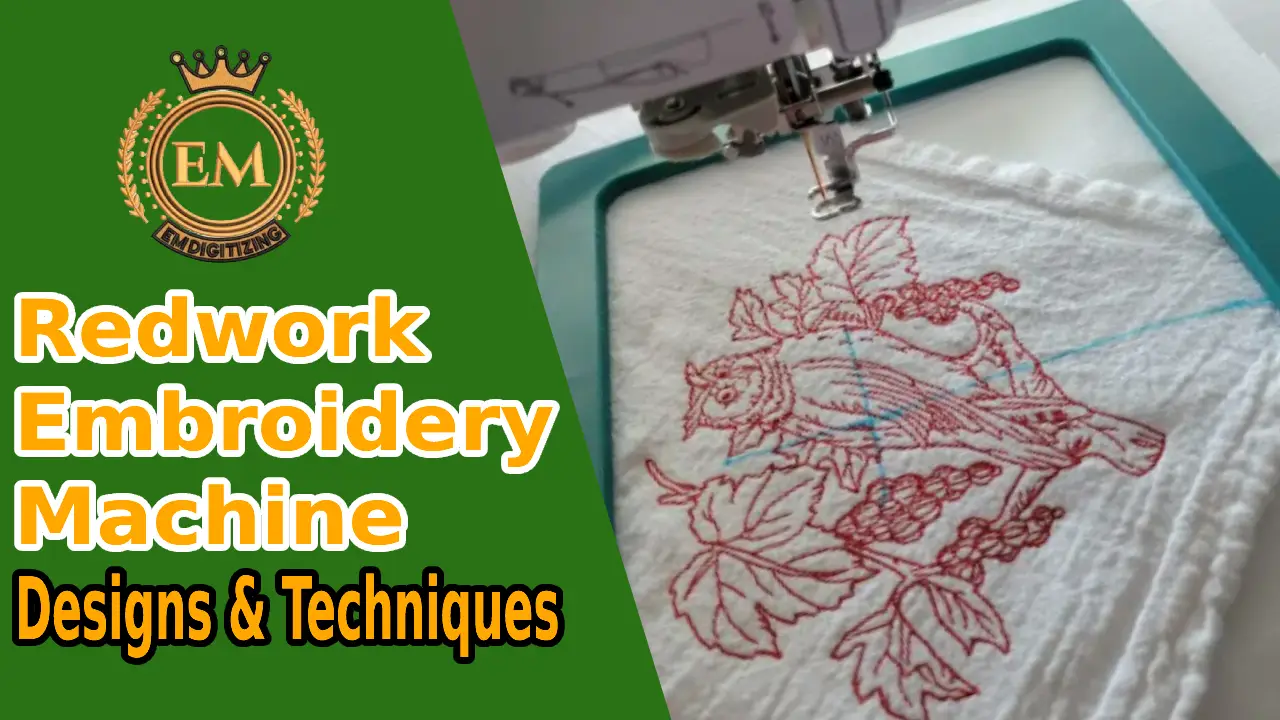
Servizi di digitalizzazione del ricamo
Cos'è il ricamo Redwork?
Il ricamo Redwork è un'antica forma di ricamo che può essere fatta risalire all'Europa orientale all'inizio del XIX secolo.
Il filo era tinto di rosso ed è stato il primo filo di cotone colorato utilizzato nel ricamo, prima di questo colorato filo era fatto di seta e poteva essere usato solo dai ricchi.
Questo tipo di ricamo era popolare perché era necessario meno filo per creare il ricamo disegno del ricamo. È stato anche molto veloce sviluppare un design. Oltre a questi fattori, il basso costo fece sì che i ricami in rosso si diffondessero rapidamente in altre parti del mondo.
Quali punti usi nel ricamo Redwork?
Il ricamo Redwork utilizza pochissimi punti, il che lo rende ottimo per gli studenti di ricamo. Redwork disegni da ricamo sono delineati con poche o nessuna area riempita. Perciò, gli schemi di ricamo redwork gratuiti presenti in questa pagina sono facili e veloci da completare!
Il punto principale utilizzato nel ricamo in rosso è il punto gambo, è noto anche come contorno o punto indietro. Come rifacimento disegni da ricamo sono delineati, questo è il punto che viene utilizzato più spesso.
Altri punti includono un punto pieno, che viene utilizzato per riempire piccoli spazi in un disegno. Ci sono anche cuciture divise, e i nodi francesi vengono utilizzati per aggiungere piccoli dettagli ai ricami in rosso. Questa pagina è piena di risorse per apprendere i punti base utilizzati nel ricamo in rosso!
Tecnica di ricamo Redwork
Basta con la lezione di storia! Come facciamo effettivamente a rielaborare?? Per la sua semplicità, redwork è un ottimo punto di partenza per i nuovi produttori di aghi e i giovani artisti degli aghi. I cinque tipi di punti sono facili da imparare, e segui semplicemente le linee del motivo stampato.
- UN Punto corrente immerge su e giù per il tessuto, creando una linea come una trapunta. L'obiettivo è posizionare punti equidistanti per dimostrare abilità.
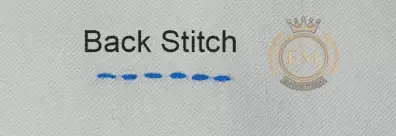 UN Punto indietro è una serie di punti pari, di solito funzionava da destra a sinistra, partendo dall'ultimo punto e poi indietro attraverso l'apertura del punto precedente.
UN Punto indietro è una serie di punti pari, di solito funzionava da destra a sinistra, partendo dall'ultimo punto e poi indietro attraverso l'apertura del punto precedente.
- Il Punto stelo sta lavorando da sinistra a destra. Ancora, con punti pari, questi si annidano l'uno contro l'altro per creare una linea solida. Il filo è stato posizionato sotto l'ago.
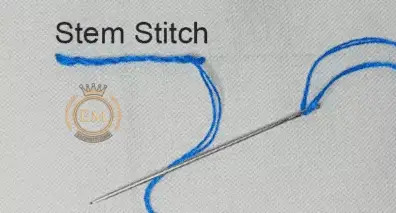
- Il Punto contorno è simile al punto erba, ma il filo è posizionato sopra l'ago.
- Il Punto Kensington è quello che mia mamma chiamerebbe un punto diviso. Da quando è arrivato il filo interdentale 6 fili, Puoi usare 2, 4, o 6 fili. Il filo si rompe, creating little hearts or “;eyes of the needle.”; This stitch was the hardest to master because I had to count the strips, but it gets easier.
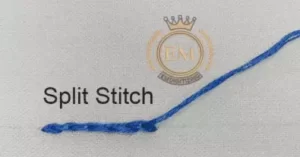
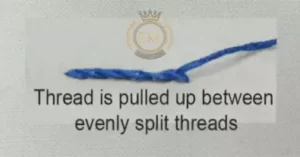
Redwork Embroidery Patterns
Most of the patterns were very easy to sew. Animals, flowers, toys, and children are all popular themes. Pictures of famous buildings and people were also stitched, as well as lively storybooks and nursery rhyme characters. Magazine publishers gave samples to promote subscriptions. As the equipment became more readily available, sometimes they would offer kits. Wealthy women used the images as models in children’;s coloring books and other advertisements.
Stamping cloth – transferring designs onto cloth – became a source of income for many women. Some manufacturers hired professional stampers, e alcune donne svolgevano questo lavoro secondario da casa. In giro 1870, i trasferimenti sono stati sviluppati su ferro. Usare un ferro caldo era un modo semplice per applicare il disegno al tessuto.
Sono stati venduti quadrati prestampati pronti per il ricamo. Il loro valore reale è di circa un centesimo, so they were commonly called “;penny squares”;. Questi quadrati venivano ricamati e cuciti insieme per formare copriletti o trapunte. Inoltre, ai bambini sono stati dati dei penny quadrati per imparare e praticare il ricamo a mano.
Disegni di ricamo a macchina Redwork
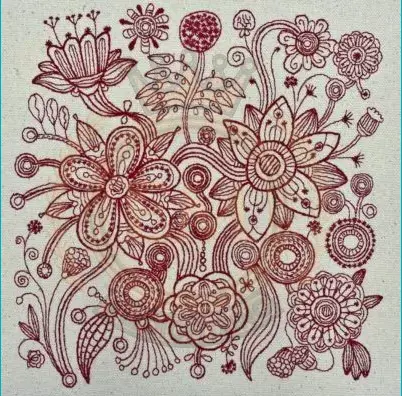
Come per qualsiasi tecnica di ricamo, non tutti i disegni da ricamo sono uguali. Quando usi i disegni sul tuo macchina da ricamo, vuoi assicurarti che funzionino senza intoppi e non rovinino il tuo capo.
Ti consigliamo di utilizzare sempre un disegno del ricamo che sai ti darà i migliori risultati. Emdigitalizzazione is sure to always give you the best results as our redwork designs are of the best quality and personally digitized by the world’;s most acclaimed digitizer.
With hundreds of redwork embroidery designs to choose from, we’;re sure there’;s a redwork embroidery design to suit your creative needs. You can view many of our Emdigitizing Disegni da ricamo by cliccando qui.
Digitizing Custom Redwork Machine Embroidery Designs
Hatch embroidery software has a redwork setting designed to give exactly two passes to create an even stitch of traditional redwork. Honestly, it’;s compelling, and it provides the ability, with practice, a digitalizzare hand lettering and reproduce designs.
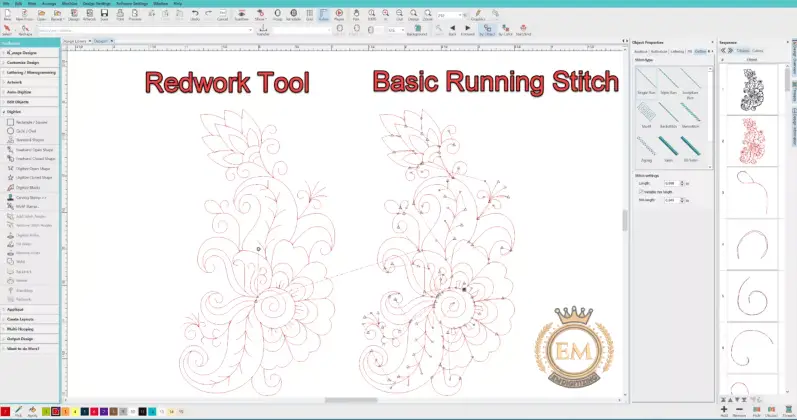
Sounds too good to be true? It’;s not, but it requires you to be a bit of a detective. The redwork needs to be expertly routed so that the lines flow from one to the other.
When looking at a pattern, you need to figure it out before you start jumping and clicking. Figure out your flow and work from a logical start to finish. You will need to stitch your start and stop points (green plus and red diamond) from person to person to work as a bucket brigade.
Idealmente, you’;LL digitalizzare the entire pattern as one pass with no trim, but if you can’;t (say you’;re working on a quilt square with four repeating motifs), then Be sure to start and stop each part of the motif flow.
Conclusione
Silhouettes of children or carefully digitized images of people are excellent, albeit challenging, soggetti. In the spirit of traditional redwork, use turkey red, blu, viola, o verde, and let yourself get creative with just one color.
Now if you want to create redwork but don’;t want to digitize your designs, don’;t forget to check out Emdigitalizzazione’s huge collection of standard redwork disegni da ricamo by cliccando qui.
Redwork or linework is a simple form of “;art needlework”; in which the outline of a design is stitched onto white or off-white fabric in red thread or a different color, but it is usually a one-color design. . Beginning in the 19th century, redwork today is commonly called backstitching or outline stitching.
The main stitch used in redwork is the backstitch or outline stitch, formerly known as the Kensington stitch. Redwork was a common introductory form of embroidery taught to children in the 19th and 20th centuries.
The redwork designs were basic and rather whimsical line drawings of children, uccelli, flowers, a water pump, and other objects found around every home at the time.
Redwork quilts, or quilts consisting of outline embroidery stitches in red thread, were popular as fundraising quilts in the late 1800s and early 1900s.
Due to the widespread popularity of redwork today, hundreds, perhaps thousands, of vintage designs have been reproduced for use. Redwork became popular in the late 1870s. The name is derived from the embroidery thread known as Turkey Red.
